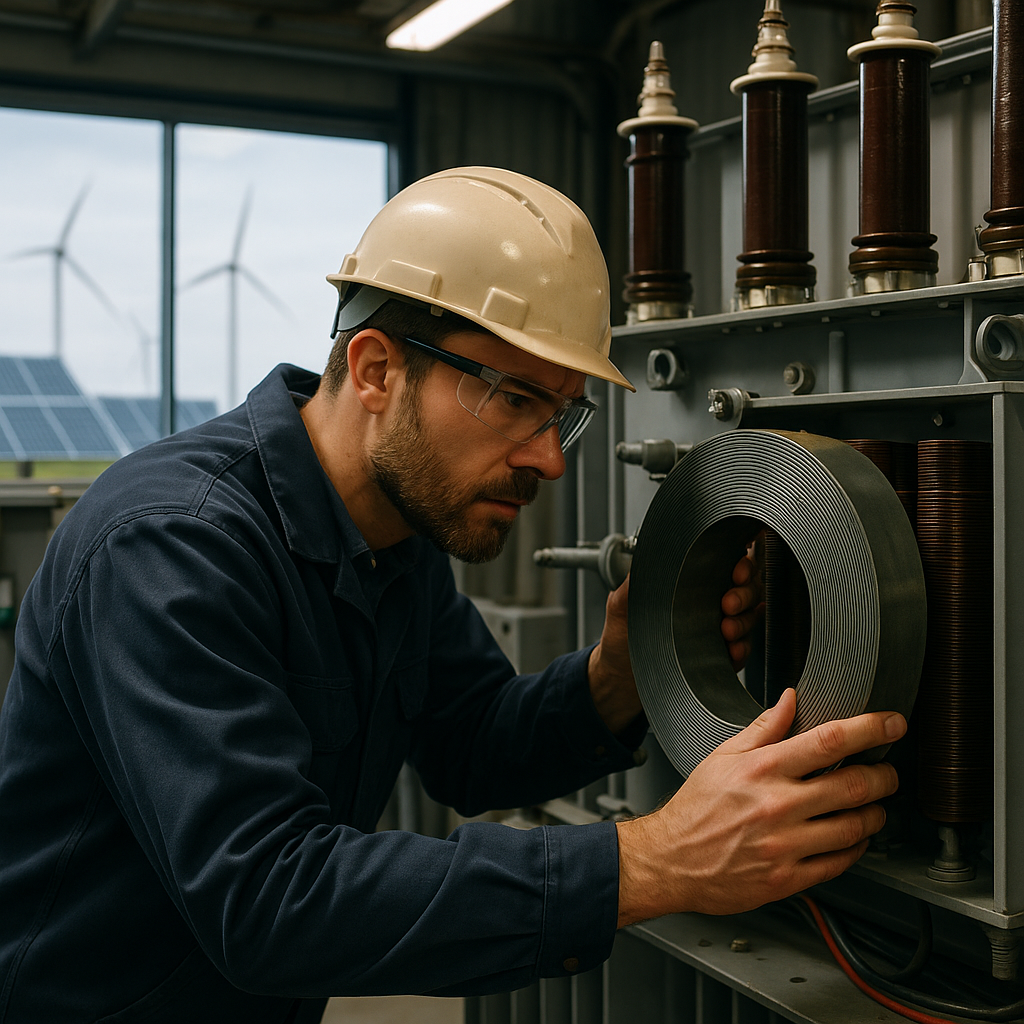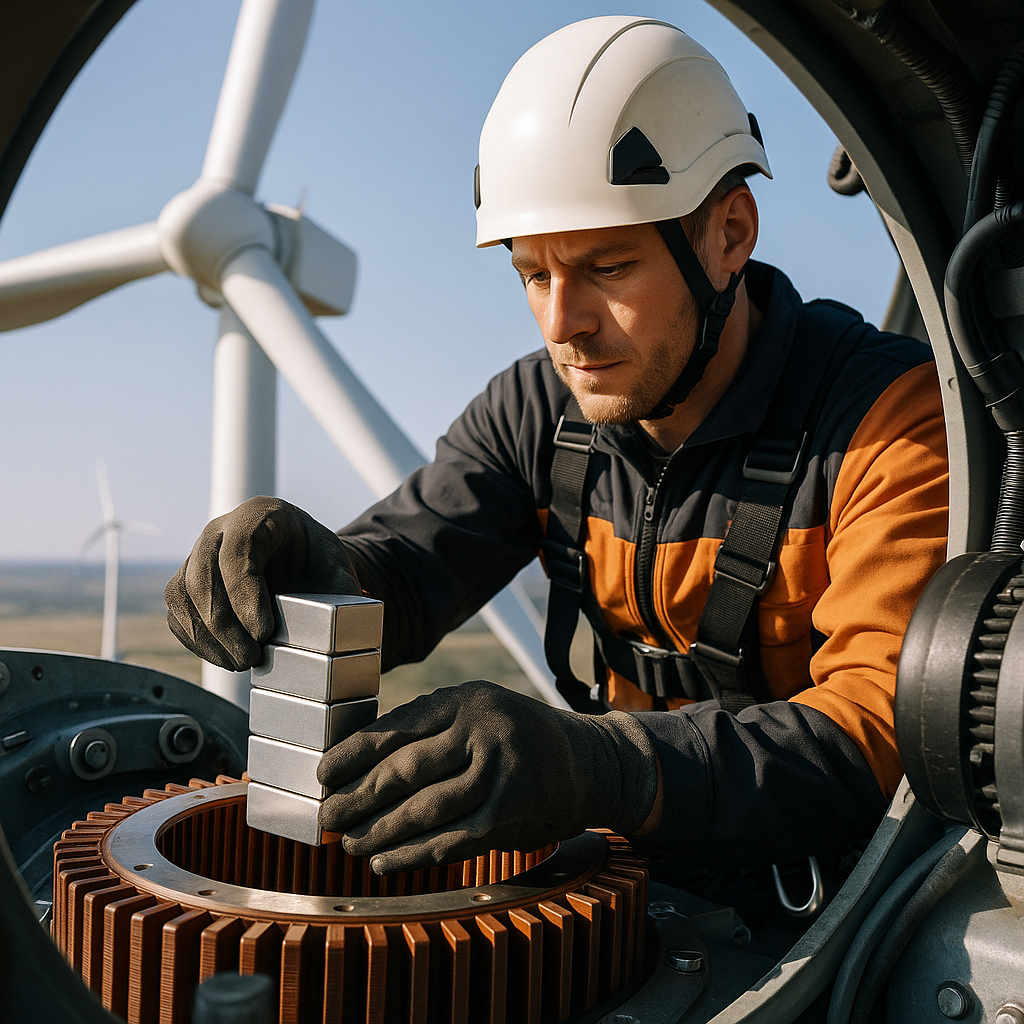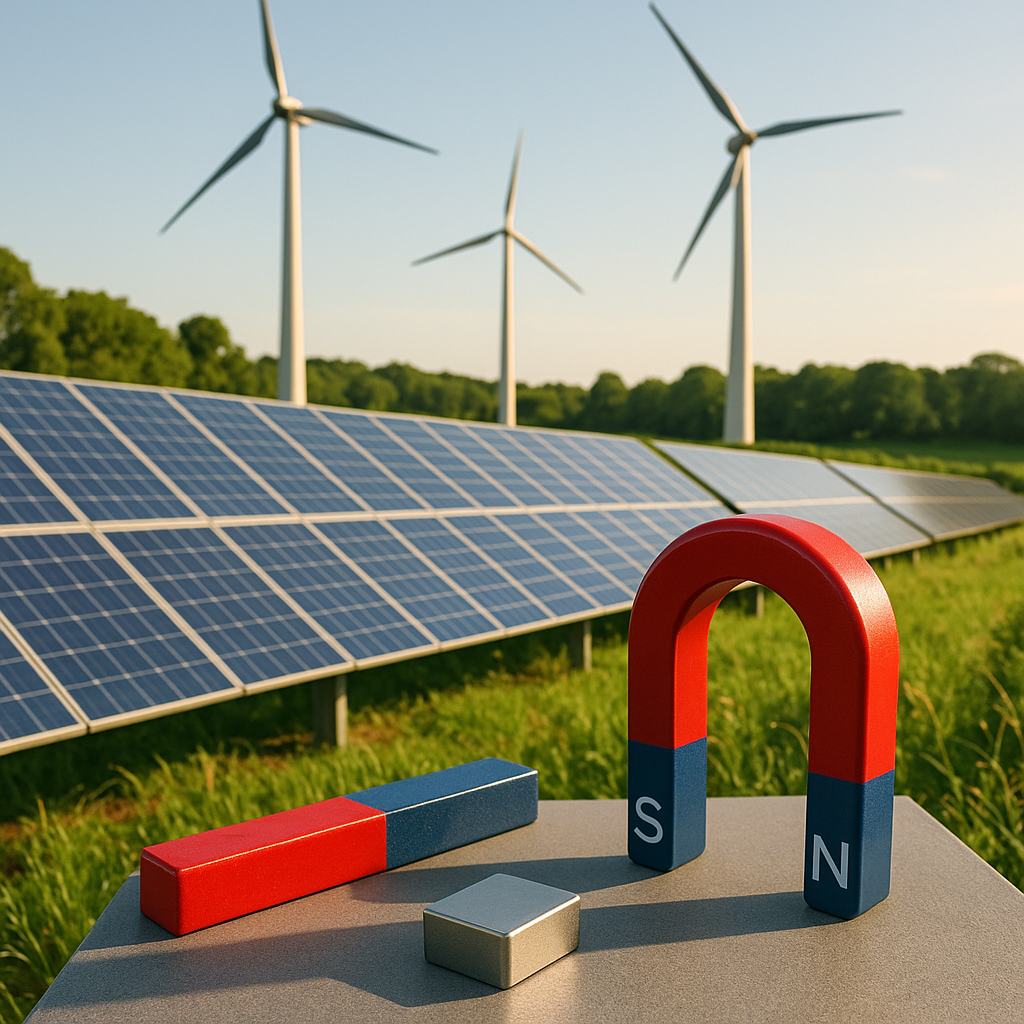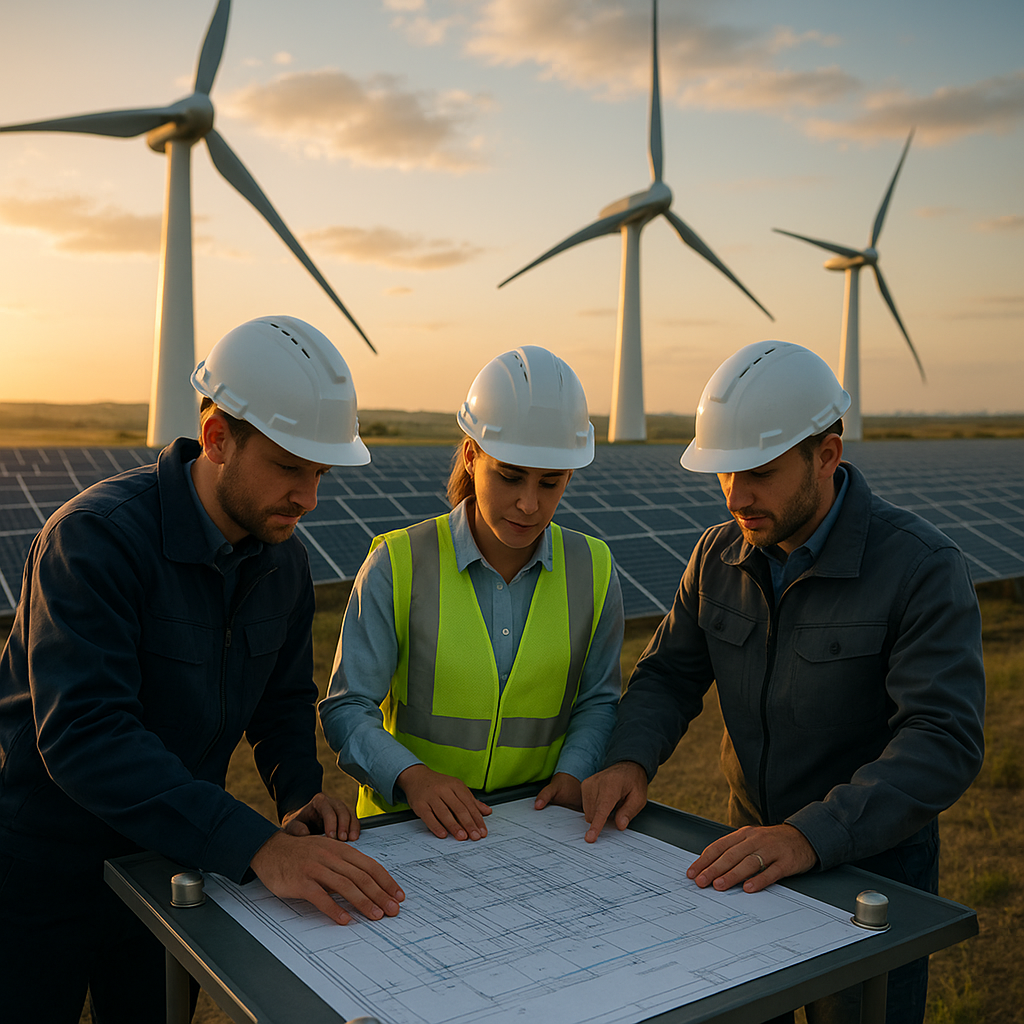5901 Botham Jean Blvd, Dallas, TX 75215
What Are Industrial Magnets in Renewable Energy Systems?
June 21, 2025Industrial magnets are essential to modern renewable energy technologies. These powerful components convert mechanical movement into electricity for our homes and businesses. From the towering wind turbines along coastlines to the large hydroelectric installations harnessing river power, industrial magnets are the silent workhorses enabling clean energy.
These magnets are typically crafted from rare earth elements, with neodymium-iron-boron (NdFeB) compounds being the standout performers. NdFeB magnets are remarkable for their exceptional magnetic strength despite their small size. A NdFeB magnet no larger than a coin can generate a field strong enough to lift objects hundreds of times its weight.
The renewable energy sector utilizes these impressive properties in generators where the magnets create magnetic fields that interact with copper coils. When kinetic energy from wind or flowing water causes these components to move relative to each other, electricity flows. This process occurs without the traditional gearboxes older systems relied on, reducing maintenance needs and extending system lifespan.
How Do Magnetic Cores Enhance Renewable Energy Efficiency?

Magnetic cores are specialized devices that guide and control magnetic fields in renewable energy systems. These components efficiently concentrate and direct magnetic flux, resulting in substantial performance improvements. For both large-scale wind farms and residential solar installations, magnetic cores are critical efficiency enhancers.
In wind turbines, magnetic cores are integrated into generators to transform kinetic energy into electricity. The cores increase magnetic field strength, allowing turbines to generate more power even during periods of variable wind speeds. This capability is especially valuable in areas where wind conditions fluctuate throughout the day.
Solar panel systems also benefit from magnetic cores in their inverters and transformers. These components help convert and stabilize the electrical output from photovoltaic cells. When a magnetic field is applied to photovoltaic cells, it enhances electron mobility and decreases charge recombination losses, leading to improved energy capture rates.
Reducing Energy Losses
One of the most significant advantages of magnetic cores is their ability to minimize energy losses. Traditional energy systems often suffer from resistance-related losses during power generation and transmission. Magnetic cores help overcome this challenge by providing efficient pathways for electricity flow.
Amorphous magnetic cores offer particularly impressive benefits when it comes to loss reduction. These specialized cores have significantly lower hysteresis losses compared to conventional ferrite cores. Hysteresis refers to the lag in material response to changing magnetic fields, which results in wasted energy.
Similarly, magnetic cores reduce eddy current losses. Eddy currents are circular patterns of electricity that form in conductors when exposed to changing magnetic fields. These unwanted currents convert electrical energy into heat, reducing system efficiency. Amorphous cores minimize this effect, making renewable energy systems more productive.
Benefits of Different Core Materials
The choice of magnetic core material can dramatically affect renewable energy performance. Amorphous cores, with their non-crystalline atomic structure, provide excellent efficiency advantages. These cores resist magnetic saturation and maintain consistent performance across varying load conditions.
Silicon steel cores represent another valuable option for renewable applications. Although they don’t match the performance of amorphous cores, silicon steel provides a balance between cost and efficiency. Many commercial wind turbines use silicon steel cores in their generators due to this practical compromise.
For high-frequency applications in solar inverters, ferrite cores often prove most suitable. Their ability to operate efficiently at higher frequencies makes them ideal for modern solar power conversion systems. This diversity of materials allows engineers to select the optimal core type for specific renewable energy requirements.
Real-World Efficiency Improvements
The efficiency gains from magnetic cores translate into measurable benefits for renewable energy systems. Wind turbines equipped with optimized magnetic cores can convert up to 5% more kinetic energy into electricity than those with standard components. This seemingly small percentage represents significant additional power generation when deployed across an entire wind farm.
Solar power systems see similar improvements. Inverters using advanced magnetic cores operate with reduced conversion losses. This efficiency boost is particularly valuable in large-scale solar installations, where even minor improvements multiply into substantial energy gains.
Beyond power generation, magnetic cores enhance energy storage applications for renewables. In smart grid systems, magnetic cores help harvest energy efficiently and regulate electricity flow. This capability becomes increasingly important as renewable energy adoption grows and grid stability requirements increase.
The transformative impact of magnetic cores extends across the renewable energy spectrum. From improving generator performance to enhancing power conversion and transmission, these components play an essential role in maximizing clean energy efficiency. As renewable technology continues advancing, magnetic cores remain fundamental building blocks of sustainable power systems.
| Magnetic Core Type | Efficiency Features | Advantages | Disadvantages | Best Applications |
|---|---|---|---|---|
| Amorphous Magnetic Cores | Lower hysteresis losses, reduced eddy current losses | Higher permeability, lower coercive force, excellent resistance to magnetic saturation | Higher cost compared to traditional cores | Wind turbines, variable load conditions |
| Silicon Steel Cores | Good balance between performance and cost | Widely available, established technology | Less efficient than amorphous cores | Commercial wind turbines, cost-sensitive applications |
| Ferrite Cores | Efficient at higher frequencies | Lower cost, widely available | Lower magnetic strength, higher hysteresis losses | Solar inverters, high-frequency applications |
| Nanocrystalline Cores | Very low core losses, high saturation flux density | Excellent thermal stability, compact size | Higher manufacturing complexity | High-performance renewable energy systems |
What Role Do Permanent Magnet Generators Play in Hydroelectric Sustainability?
Permanent magnet generators (PMGs) are enhancing hydroelectric power generation by significantly improving energy conversion efficiency. These generators integrate powerful magnets directly into the rotor, creating a consistent magnetic field without external power sources. This design allows PMGs to convert water’s kinetic energy into electrical power with minimal energy loss.
Compared to traditional generators with field coils, PMGs demonstrate superior efficiency. The absence of external excitation systems reduces energy consumption while maximizing output. Hydroelectric facilities using permanent magnet technology typically achieve efficiency improvements of 5-10% over conventional systems, translating into more kilowatt-hours produced from the same water resources.
Maintenance requirements are another area where PMGs offer substantial sustainability benefits. The simplified construction of permanent magnet generators—with fewer moving parts and the elimination of components like slip rings and brushes—dramatically reduces maintenance frequency and costs. Plant operators report up to 30% lower maintenance expenses after switching to PMG systems.
The durability and operational lifespan of PMGs further enhance their sustainability. With robust construction and minimal wear points, these generators typically function reliably for 20-25 years with proper maintenance. Reduced mechanical stress and elimination of field coil degradation issues mean fewer replacements and less resource consumption over the facility’s lifetime.
From an environmental perspective, PMGs support hydroelectric sustainability by maximizing energy harvest from existing water resources. The higher conversion efficiency means more renewable energy production without expanding the physical footprint or water requirements of hydroelectric installations. This efficiency is particularly valuable in smaller hydroelectric applications, where every percentage point of improved performance significantly impacts viability.
The economic sustainability of PMGs is compelling despite their higher initial investment. The combination of increased energy output, reduced maintenance costs, and longer operational lifespans typically delivers a positive return on investment within 5-7 years. Over a facility’s lifecycle, the total ownership costs are often substantially lower than with traditional generator systems.
PMGs also contribute to system reliability, a critical factor in sustainable power generation. Their ability to operate efficiently across varying water flow rates helps maintain consistent power output even during seasonal fluctuations or changing water conditions. This operational flexibility reduces the need for backup power systems and stabilizes grid contributions from hydroelectric sources.
| Feature | Permanent Magnet Generators | Traditional Generators |
|---|---|---|
| Efficiency | Higher efficiency (5-10% improvement) | Lower efficiency due to field coil losses |
| Energy Conversion | Improved energy conversion with no external power for excitation | Requires external power sources to energize windings |
| Maintenance | Up to 30% lower maintenance costs, simplified construction | Higher maintenance requirements due to slip rings and brushes |
| Durability | 20-25 year lifespan with minimal wear points | Shorter operational lifespan with more component degradation |
| Design | Compact, lightweight structure with magnets in rotor assembly | More complex design with field coils |
| Environmental Impact | Lower carbon emissions, no need for external power sources | Higher environmental impact due to additional power needs |
| ROI Timeline | Higher initial cost with ROI within 5-7 years | Lower initial cost but higher lifetime expenses |
| Performance at Variable Flows | Operates efficiently across varying water flow rates | Less responsive to flow variations |
The integration of permanent magnet generators into hydroelectric systems represents a significant advancement in sustainable energy technology. By improving efficiency, reducing maintenance requirements, extending operational lifespans, and enhancing system reliability, PMGs are helping transform hydroelectric power into an even more sustainable energy solution for the future.
How Are Magnets Advancing Wind Turbine Technology?

Permanent magnets are transforming wind energy production through their use in advanced generator systems. These magnets are crucial to Permanent Magnet Synchronous Generators (PMSGs), which have become a breakthrough for modern wind turbines. Unlike conventional generators, PMSGs maintain high efficiency across variable wind speeds, capturing more energy even during gentle breezes.
A major advancement is the direct-drive configuration. These systems eliminate the need for gearboxes, traditionally the weak point of wind turbines, due to their numerous moving parts prone to failure under constant stress from changing wind conditions. Removing this component enhances turbine performance significantly.
Without gearboxes, turbines become lighter and mechanically simpler. This weight reduction decreases structural requirements and installation costs while allowing for larger rotor diameters. The lightweight design enables manufacturers to build taller towers that access stronger, more consistent wind resources at higher altitudes.
Maintenance needs decrease significantly with direct-drive permanent magnet systems. A 2018 study by Vattenfall showed that wind turbines using permanent magnet direct-drive generators produced up to 25% more power in low-wind conditions than traditional generators. This increased reliability leads to higher uptime and lower operational costs over the turbine’s lifespan.
The efficiency gains from permanent magnets extend beyond mechanics. These generators convert wind energy to electricity with minimal loss. Even in fluctuating wind conditions, PMSGs maintain optimal power generation, where conventional systems struggle to adapt quickly. This responsiveness allows these advanced turbines to harvest energy from wind speeds too low for older models.
For offshore wind farms, where maintenance access is challenging and costly, permanent magnet generators offer significant advantages. The Hornsea Project One wind farm in the UK uses compact generators with neodymium magnets to generate 1.2 GW of power, enough to supply electricity to over one million homes. The reduced maintenance needs and enhanced durability make these systems ideal for harsh marine environments.
The environmental benefits increase throughout the turbine’s extended operational life. Data from the U.S. Department of Energy indicates that direct-drive turbines with permanent magnets can operate up to 30 years with minimal maintenance, compared to 20 years for traditional gear-driven turbines. This longevity boosts lifetime energy output and enhances the sustainability profile of wind energy investments.
What Are the Environmental Benefits of Using Industrial Magnets in Renewable Energy?

Industrial magnets play a crucial role in enhancing the environmental performance of renewable energy systems. These powerful components improve energy conversion efficiency across various renewable technologies, significantly impacting our environment.
In wind energy systems, high-strength permanent magnets enable generators to convert wind’s kinetic energy into electricity more efficiently. Modern wind turbines using neodymium magnets can operate at lower wind speeds and extract more energy from each rotation, maximizing clean electricity production without additional resource consumption.
The environmental benefits extend beyond efficiency improvements. Permanent magnet generators in renewable energy systems operate without requiring external power sources for excitation. This self-sufficient operation eliminates additional energy inputs and their associated carbon emissions, creating a truly clean energy cycle.
Magnetic technology also contributes to substantial carbon emission reductions. By improving the efficiency of renewable energy systems, magnets help displace more fossil fuel-based electricity generation. Each megawatt-hour of renewable energy produced using efficient magnetic systems can prevent approximately one ton of CO2 emissions compared to coal-fired generation.
The durability of magnet-based systems provides another layer of environmental benefit. Industrial magnets used in renewable energy applications are designed to withstand harsh environmental conditions with minimal degradation over time. This resilience translates to less frequent replacements and reduced manufacturing impacts.
Magnet-based renewable energy systems also require less maintenance than conventional alternatives. Permanent magnet generators have fewer moving parts and don’t require maintenance-intensive components like slip rings and brushes. This reduction in maintenance activities means fewer replacement parts, less transportation for service teams, and reduced use of lubricants and other maintenance materials.
The combination of these factors creates a virtuous environmental cycle. More efficient energy conversion leads to greater renewable energy deployment, accelerating the transition away from fossil fuels. As the renewable energy sector grows, economies of scale drive down costs, making clean energy more accessible and further reducing global emissions.
In hydroelectric applications, magnetic systems improve efficiency while minimizing environmental disruption. Magnetic generators in hydroelectric plants can operate efficiently at variable water flow rates, maximizing energy capture from existing water resources without requiring additional dam construction or river modifications.
Conclusion: The Future of Industrial Magnets in Renewable Energy

Industrial magnets have become essential components in advancing renewable energy technologies. Their role in enhancing wind turbine efficiency through direct-drive generators has transformed wind energy capture. Similarly, in hydroelectric systems, magnetic materials have improved power conversion rates and reduced maintenance needs.
The development of alternative magnetic materials, particularly iron-nitride magnets, provides sustainable options to rare-earth components. These innovations address environmental concerns and supply chain vulnerabilities that have historically challenged the industry. As magnet technology evolves, we can expect more efficient energy generation systems operating at lower costs with less ecological impact.
For businesses and municipalities looking to implement sustainable waste management practices and contribute to the circular economy, contact Okon Recycling at 214-717-4083.
